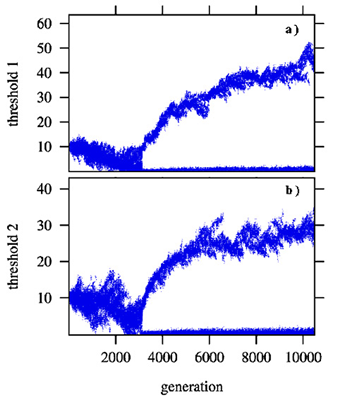The evolution of self-organized division of labour
Division of labour is a key determinant of the ecological success of eusocial insects. However, the seemingly harmonious functioning of a colony with often thousands of individuals is not well understood. Self-organization models demonstrate that division of labour at the colony level may be an emergent property of the interaction of many agents, each of which being guided by relatively simple behavioural rules. These models may provide a proximate explanation for division of labour, but they lack an evolutionary perspective. Conversely, evolutionary models focus on the relationship between division of labour and colony fitness, thereby neglecting the behavioural mechanisms underlying division of labour. In a recent review (Duarte et al., Ann. Rev. Ecol. Evol. Syst., in press), we plead for an integration of both approaches. In a nutshell, we consider organisms with a simple but relatively open behavioural architecture (like a neural network). The characteristics of this architecture (e.g., the number and type of neurons, the connections among neurons and their properties) are heritable properties, which are subject to mutation and natural selection. The behaviour of each individual is governed by its inherited architecture, and the joint behaviour of all individuals in the colony determines (via self-organized division of labour) the reproductive success of the colony. This way, successful architectures, that is, architectures leading to well-coordinated colony behaviour will be selected.
We have applied this approach in various models that have led to some interesting insights. First of all, we could show that self-organized division of labour can indeed evolve from scratch, that is, from a genetically and phenotypically undifferentiated population. This is illustrated by Figure 1, which is based on the "fixed threshold model", the textbook example for self-organized division of labour. In the original self-organization model, there are – from the start – two types of workers with different thresholds for two different tasks. It is not too surprising that the workers with a low threshold for task 1 specialized on performing task 1, while the workers with a low threshold for task 2 specialized on task 2. The question is how the differentiation in thresholds occurred in the first place. Figure 1 demonstrates that disruptive selection can lead to threshold differentiation and, thus, division of labour, in an initially undifferentiated population. Our second insight was that the situation in Figure 1 is far from representative. Threshold differentiation will only occur under highly specific circumstances. It is more representative that all thresholds converge to zero, thus undermining the threshold mechanism. Third, the 'bauplan' underlying the behavioural architecture matters a lot. For example, self-organized division of labour evolves much more easily in a neural network model than in a threshold model. However, the evolved networks have some strange properties. Moreover, the evolutionary outcome is not robust in the sense that small changes in the model assumptions (e.g., the way task performance affects colony fitness) may have major effects on the types of networks that evolve. All in all, we have to conclude that the evolution of self-organized division of labour is not yet well understood.

